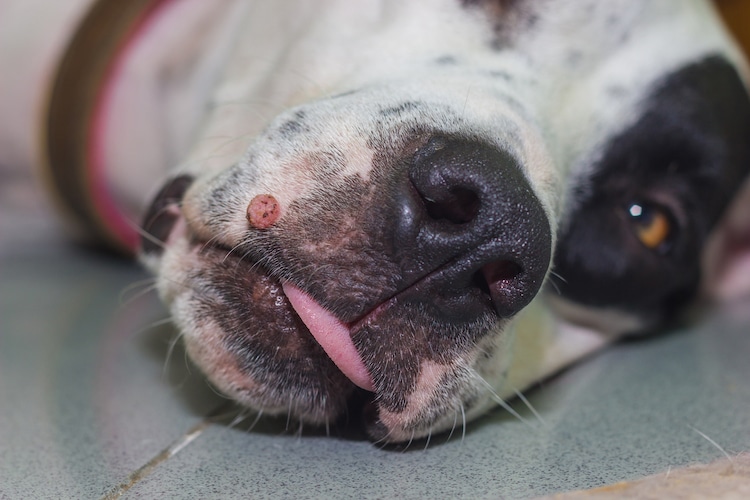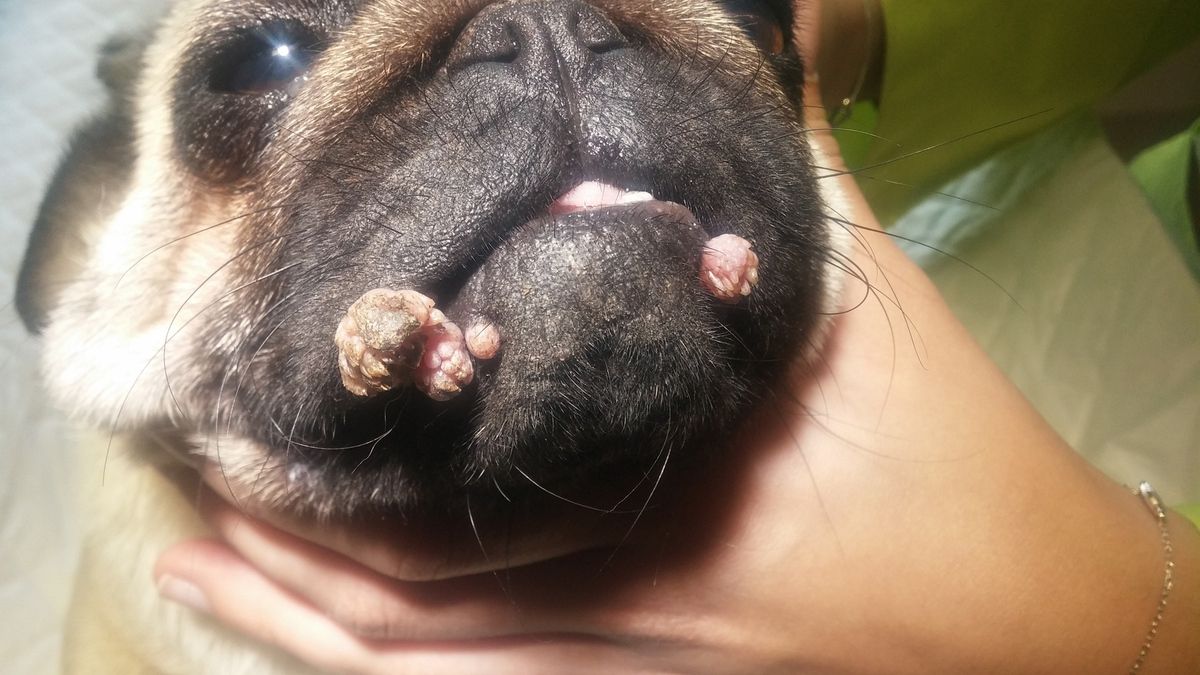Papillomatosis dog
Papillomatosis is a viral disease that is recognized by the development of papillomas on the dog's skin, a nice word for warts.
These benign tumors are generally without danger for the health of the dog, and present above all an unaesthetic character which is indifferent to the animal, but can annoy the master. However, it is important to know how to distinguish these small harmless masses from malignant tumors, which need to be treated when possible.
What is canine papillomatosis?
Dog papillomatosis is a viral disease caused by a papillomavirus. Different parts of the dog's body can be affected, both the skin and the mucous membranes. There are different canine papillomaviruses that can infect dogs, which are mainly distinguished by the areas of the body that they colonize and on which papillomas appear.
Papillomas are benign tumors, usually rough and protruding, commonly called warts. These small growths are easily recognized by their irregular "cauliflower-like" appearance, although there are also smooth ones. They can be of various colors (black, brown, beige, pink, etc.).
The papillomavirus is transmitted by direct or indirect contact. Once the host is infected, the virus colonizes the cells of the skin and/or mucous membranes and causes warts to appear. It is important to note that not all dogs develop papillomatosis when infected with HPV. Only dogs with weak immune systems will show symptoms.
HPVs are highly contagious and resistant, and can survive for long periods of time on inert surfaces in the open air and resist washing with detergent. In fact, there is a good chance that a dog will contract HPV during its lifetime, but it will not develop HPV, and therefore may not develop warts.
While papillomatosis in dogs is usually benign, it should be noted that it can become complicated by skin cancer in rare cases. This can occur when papillomas are regularly traumatized, creating an inflammatory environment for cancer cells to develop, but also in cases of recurrent papillomatosis and when dog warts are exposed to the sun.
Causes of Papillomatosis in dogs
Papillomatosis is caused by a virus of the papillomavirus type, but not only. Indeed, if many dogs can be carriers of papillomavirus, only some of them will develop skin lesions - namely papillomas. For reason, the papillomas appear only when the body of the dog does not manage to control the proliferation of the virus in the sites of infection.
Also, it is primarily dogs with weakened immune systems that develop this condition, and the weaker the dog's body's defenses are, the greater the lesions. Dogs with congenital or acquired immunodeficiency, those treated with corticosteroids, animals that are already sick and young puppies are therefore the most at risk.

The different Papillomatoses of the dog
There are as many canine Papillomatoses as there are canine papillomaviruses, of which we still know only 8 species (against more than a hundred in humans).
Labial or oral papillomatosis of the puppy
Oral Papillomatosis is a disease that preferentially affects dogs under 2 years old and immunocompromised animals. Very virulent, it can give rise to spectacular symptoms. Its aggressiveness is explained by the young age of the animal, whose immune system is not yet fully operational, which gives the virus great latitude to act.
The virus causes warts to appear in the dog's mouth and on the surrounding tissues (chin, trench, lips, etc.), often forming clusters of very protruding and crenellated warts that are particularly unsightly. If the eruption of warts is impressive, it is most often well supported by the dog and painless. The lesions resolve on their own, usually in 4 to 8 weeks, although it can take longer (up to 6 months). Recurrences are rare, although somewhat more common in the immunocompromised dog, when his immune deficiencies are persistent. In most cases, the condition leaves no sequelae.
Cutaneous Papillomatosis of the Old Dog
Old Dog Papillomatosis, or Cutaneous Exophytic Papillomatosis, preferentially affects older animals, whose immune systems are less effective due to aging. The Kerry Blue Terrier and Cocker Spaniel are somewhat more represented than other breeds. As with oral papillomatosis in puppies, immunocompromised dogs can also be affected by this disease.
This Papillomavirus manifests itself by the appearance of benign skin tumors that can colonize all parts of the animal's body, from the head to the tip of the tail, including the limbs, fingers, eyes and trunk. Symptoms are usually more discreet than the oral form, and the warts are more scattered and smaller. The lesions take longer to disappear, sometimes more than a year, and may even remain for life.
Other types of papillomatosis in dogs
More episodically, papillomatoses can affect the conjunctiva, genitals, and pads of dogs. These forms are more common in young and immunocompromised dogs and are often associated with oral papillomatosis.
Patchy, relatively smooth, low-profile warts are also a specific form of papillomatosis that is more common in Carlins and Schnauzers. Finally, there are inverted papillomatoses that form small craters on the dog's skin and most often develop on the belly.
Treatment of Papillomatosis in dogs
There is no specific treatment to eliminate warts caused by Papillomatosis, nor to destroy the virus. Furthermore, it is generally not useful or effective to treat a dog with Papillomavirus. In fact, the virus is rarely life-threatening to the dog, and the unsightly warts it causes will eventually disappear on their own.
Some owners often insist on having their dog's warts surgically removed for aesthetic reasons, but this type of procedure does not help the animal and does not eliminate the virus from its body. On the other hand, when the mass(es) are located on traumatic or embarrassing sites, a surgical intervention can be justified.
This may be the case for warts located on the dog's paw pads, which become irritated when the animal walks or when it touches its claws, but also for certain masses colonizing the mucous membranes, especially the trachea. In the most severe cases of labial papillomatosis, which is more common in young dogs, the animal may need to be hospitalized to be fed and hydrated with IV fluids. If the warts are infected, antibiotics may be prescribed to avoid complications.
It is important to understand that Papillomatosis always develops in a dog with a deficient immune system, either because it is too immature or, on the contrary, too old, or because the dog suffers from an immune disease or is undergoing a medical treatment that annihilates its natural defenses (corticoids).
In fact, the treatment may seek to stimulate the dog's immune defenses to help eliminate the virus. However, this type of treatment is not always very effective. Finally, some antibiotics can accelerate the disappearance of warts, but this type of treatment is still being tested and its mechanism of action is not yet fully understood.

FAQ
How do I know if my dog has Papillomatosis?
Papillomatosis is the appearance of warts on the skin and/or mucous membranes of a dog. These can be isolated or form clusters that can be very spectacular. Typically, the warts are irregular, pigmented and not inflamed (unless they are located on a site exposed to rubbing or other trauma).
My dog has warts, what should I do?
There is no need to do anything if your dog has warts, unless they are in his mouth and prevent him from eating, drinking or breathing properly. They will disappear on their own, after one to five months in young dogs, and six to twelve months in older animals. It is still important to keep an eye on them to make sure they don't get infected if they are exposed to rubbing. Also, it's always a good idea to see a veterinarian to make sure it's a wart and not a malignant tumor or other type of lesion.
What is Papillomatosis in dogs?
Papillomatosis is a disease caused by a virus of the papillomavirus family, which manifests itself by the appearance of warts on the skin and/or mucous membranes of the dog. It is a pathology that can be very impressive when the warts are numerous and/or large, but it is benign in the vast majority of cases, and the warts eventually disappear on their own in a few months.
Is Papillomatosis in dogs contagious?
Yes, Papillomatosis is highly contagious, and the papillomaviruses that cause it are very resistant and can remain on inert surfaces for a long time.
Nevertheless, few dogs develop symptoms when they contract the virus. Only animals with weakened immune systems, such as puppies and older or sick dogs, develop warts. Papillomatosis is a disease that can cause spectacular wart eruptions, which can be alarming to owners.
However, in the vast majority of cases, it is a harmless disease and the warts it causes usually disappear on their own after a few months. However, if your dog has warts, it's a good idea to take him to a veterinarian to make sure that they are benign masses and not malignant tumors or other dangerous lesions.

